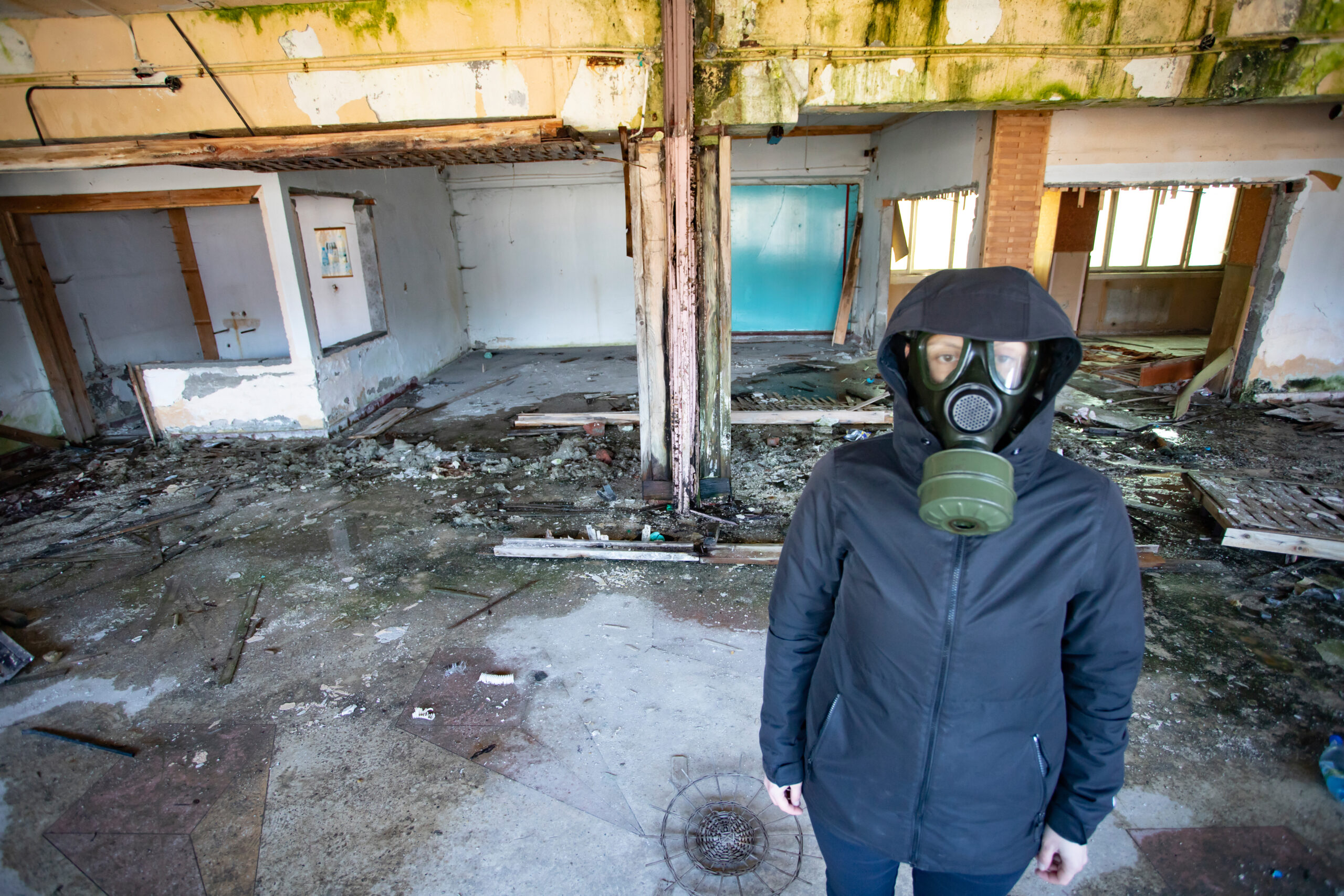Health Risks Associated with Asbestos Exposure
Asbestos exposure is a serious health hazard for construction workers. When asbestos fibers are inhaled, they can become trapped in the lungs, leading to severe illnesses over time. These include diseases like mesothelioma, lung cancer, and asbestosis. Mesothelioma, in particular, is almost exclusively caused by asbestos and is often fatal. Non-cancerous conditions, such as pleurisy and fluid buildup in the lungs, are also common. Prolonged exposure increases these risks significantly, especially for workers handling asbestos-containing materials regularly.
How Asbestos Becomes Airborne on Construction Sites
Asbestos becomes dangerous when its fibers are released into the air. This happens most often during activities like demolition, remodeling, or cutting materials that contain asbestos. Friable asbestos—materials that crumble easily—poses the highest risk because its fibers can quickly turn into airborne dust. Common tasks that release asbestos include:
- Cutting or drilling into asbestos-containing products.
- Demolishing old insulation, roofing, or tiles made with asbestos.
- Handling asbestos materials during installation or removal.
Once airborne, these microscopic fibers are easily inhaled, putting workers at immediate risk.
The Long-Term Impact of Asbestos on Workers
The effects of asbestos exposure may not appear for decades, making it a silent and long-term threat. Workers exposed to asbestos in their younger years often develop health issues much later in life. Diseases like mesothelioma and lung cancer can take 20-50 years to manifest. Additionally, these conditions are often aggressive and difficult to treat, leading to a high mortality rate. Secondary exposure is another concern, as asbestos fibers can cling to clothing and tools, potentially endangering workers’ families at home.
Identifying Asbestos-Containing Materials on Construction Sites
Common Building Materials That Contain Asbestos
Asbestos was widely used in construction materials before its health risks became well-known. Some of the most common materials include:
- Roofing shingles and tiles: Often chosen for their durability and fire resistance.
- Drywall and joint compounds: Frequently used in walls and ceilings.
- Insulation products: Found in attics, walls, and around pipes, especially in older buildings.
These materials can release asbestos fibers when disturbed, posing a serious risk to workers.
How to Recognize Asbestos in Older Structures
Recognizing asbestos-containing materials (ACMs) in older buildings can be tricky. While experienced workers might identify potential hazards based on texture, color, or labeling, visual identification alone is not reliable. If there’s any doubt, it’s safer to assume the material contains asbestos until proven otherwise.
The Role of Testing in Identifying Asbestos
Professional testing is the only surefire way to confirm the presence of asbestos. Certified inspectors collect samples and analyze them in specialized labs. This process is critical for ensuring safety, as asbestos cannot be identified by sight alone. Professional testing protects workers and anyone else who might be exposed.
Implementing Safety Protocols to Prevent Asbestos Exposure
Establishing Regulated Areas for Asbestos Work
One of the first steps in minimizing asbestos exposure is to clearly define and regulate areas where asbestos-related tasks are performed. Access to these zones should be restricted to trained personnel only. By limiting entry, you reduce the chances of accidental exposure to unprotected individuals. Proper signage, such as “Danger: Asbestos” warnings, should be posted to alert workers and visitors. Additionally, these areas should be sealed off as much as possible to prevent asbestos fibers from spreading to other parts of the site.
Using Engineering Controls to Minimize Exposure
Engineering controls play a vital role in keeping asbestos fibers contained. Systems like negative air pressure setups can prevent contaminated air from leaving the work area. Ventilation systems equipped with high-efficiency particulate air (HEPA) filters are highly effective in capturing asbestos particles. Another useful measure is the use of wet methods during tasks like cutting or drilling, as this helps to suppress dust. These controls, when properly implemented, significantly reduce airborne asbestos levels.
Developing an Asbestos Management Plan
An asbestos management plan is essential for construction sites where asbestos may be present. This plan should outline procedures for identifying, handling, and disposing of asbestos-containing materials (ACMs). Key elements include scheduling regular inspections, maintaining records of asbestos locations, and detailing emergency response protocols in case of accidental exposure. Employers should also ensure that all workers are familiar with the plan and understand their roles in adhering to it. A well-executed management plan not only protects workers but also ensures compliance with legal requirements.
The Importance of Personal Protective Equipment (PPE)
Types of PPE for Asbestos Work
When dealing with asbestos on construction sites, personal protective equipment (PPE) is not optional—it’s a necessity. Wearing the right gear can significantly reduce the risks of exposure to harmful asbestos fibers. The essential types of PPE include:
- Protective Clothing: Disposable coveralls, gloves, and shoe covers prevent asbestos fibers from clinging to your clothes and skin. These items should never leave the worksite to avoid secondary contamination.
- Respiratory Protection: Respirators are critical for filtering out airborne asbestos fibers. Options include half-face or full-face air-purifying respirators equipped with high-efficiency particulate air (HEPA) filters.
- Eye Protection: Safety goggles or glasses shield your eyes from dust and debris, adding another layer of defense.
Proper Use and Maintenance of PPE
Using PPE effectively is just as important as having it. Workers must ensure their gear fits properly and is free from damage before each use. Here are some maintenance tips to keep PPE functional:
- Inspect PPE for tears, cracks, or wear before starting work.
- Replace disposable items like gloves and coveralls after each use.
- Clean reusable equipment, such as respirators, according to the manufacturer’s guidelines to prevent contamination.
Employers should also provide training on how to properly wear and maintain PPE, ensuring workers are fully equipped to protect themselves.
The Role of Respirators in Protecting Workers
Respirators play a pivotal role in asbestos safety. Unlike basic dust masks, respirators are designed to filter microscopic asbestos fibers that can cause severe health issues. High-efficiency respirators, such as powered air-purifying respirators (PAPRs), are particularly effective as they provide a steady flow of clean air, reducing the strain on the wearer.
For maximum protection:
- Ensure the respirator fits snugly to prevent leaks.
- Use only respirators approved for asbestos work, such as those with HEPA filters.
- Regularly replace filters and check for proper functioning.
By combining the right PPE with proper training and maintenance, workers and employers can create a safer environment, minimizing the risks associated with asbestos exposure. For example, during asbestos removal, these safety measures are critical to preventing harmful fibers from becoming airborne and endangering workers.
Training and Educating Workers About Asbestos Risks
Mandatory Training Programs for Construction Workers
One of the most effective ways to reduce asbestos exposure is through mandatory training programs. These programs should cover the basics of asbestos identification, safe handling procedures, and the health risks associated with exposure. Workers must understand how to recognize asbestos-containing materials (ACMs) and the steps to take if they encounter them. Regular training sessions ensure workers stay updated on safety protocols and legal requirements.
Raising Awareness About Secondary Exposure
Secondary exposure happens when asbestos fibers are carried home on clothing, tools, or equipment, putting family members at risk. Training should emphasize the importance of hygiene practices, such as changing clothes and showering before leaving the worksite. Workers should also learn how to properly clean tools and equipment to prevent contamination. This awareness can significantly reduce the risk of secondary exposure.
Understanding OSHA Standards for Asbestos
Construction workers need to be familiar with OSHA standards, specifically 29 CFR 1926.1101, which outlines regulations for asbestos in construction. These standards include requirements for exposure limits, air monitoring, and the establishment of regulated areas. Training programs should break down these guidelines into practical steps, helping workers understand their rights and responsibilities under the law. Compliance with OSHA standards is not just a legal obligation but a critical step in protecting worker health.
For additional insights and tools, consider downloading a toolbox talk on asbestos risks to enhance workplace safety and awareness.
Safe Work Practices for Handling Asbestos
Minimizing Disturbance of Asbestos Materials
To reduce the risk of asbestos exposure, it’s critical to avoid unnecessary disturbance of materials that may contain asbestos. Asbestos fibers become dangerous when they are airborne, so handling these materials with care is essential. Workers should:
- Avoid cutting, drilling, or sanding materials unless absolutely necessary.
- Use tools and techniques specifically designed to minimize dust.
- Follow strict guidelines for any work involving asbestos-containing materials (ACMs).
Proper Disposal of Asbestos Waste
Safe disposal is a key part of handling asbestos. Improper disposal can lead to contamination and health risks for others. When disposing of asbestos waste, workers should:
- Place asbestos debris in sealed, labeled containers.
- Transport the waste to a designated disposal site that handles hazardous materials.
- Wear appropriate protective gear throughout the process to prevent exposure.
Using Wet Methods to Reduce Dust
One effective way to control asbestos dust is by using wet methods. Applying water or a water-based solution to asbestos materials helps to keep fibers from becoming airborne. This method is particularly useful during:
- Cutting or drilling tasks.
- Removal of asbestos-containing insulation or tiles.
- Cleaning up debris after work is completed.
By incorporating these practices, construction teams can significantly lower the risks associated with asbestos exposure. Regular training and site inspections further ensure that workers are prepared to handle hazardous materials safely.
The Role of Employers in Preventing Asbestos Exposure
Providing Resources for Worker Safety
Employers play a critical role in minimizing asbestos risks by providing the necessary resources to ensure worker safety. This includes offering protective gear like respirators and coveralls, as well as access to proper hygiene facilities to prevent asbestos dust from being carried home. Additionally, hiring certified professionals for asbestos abatement projects is essential to reduce exposure risks and ensure compliance with safety standards.
Monitoring and Limiting Worker Exposure
Regular monitoring of asbestos levels in the workplace is vital. Employers should establish protocols for tracking worker exposure over time and limit access to areas with known asbestos contamination. There is no safe level of asbestos exposure, so even brief contact with the material can pose serious health risks. Time spent in high-risk areas should be minimized, and employees should be informed of the dangers.
Ensuring Compliance with Legal Requirements
Employers are legally obligated to adhere to asbestos safety regulations, such as those outlined in the Control of Asbestos Regulations 2012. These laws designate specific duties to employers, including identifying asbestos-containing materials, maintaining proper records, and ensuring workers are trained in safe handling practices. Non-compliance can result in significant penalties, making it crucial for employers to stay informed and proactive in their approach.
The Legal Framework Surrounding Asbestos in Construction
Key Regulations Governing Asbestos Use
Asbestos regulations in the United States are primarily enforced by agencies such as the Environmental Protection Agency (EPA) and the Occupational Safety and Health Administration (OSHA). The EPA, for instance, has implemented rules like the Asbestos Hazard Emergency Response Act (AHERA) and the National Emission Standards for Hazardous Air Pollutants (NESHAP). These laws aim to limit asbestos use and ensure proper handling during demolition or renovation projects. Understanding these regulations is critical for maintaining workplace safety and compliance. Additionally, OSHA’s standards, such as 29 CFR 1926.1101, outline specific requirements for construction sites, including identifying asbestos-containing materials (ACMs) and controlling airborne fibers.
Employer Responsibilities Under OSHA Guidelines
Employers in the construction industry bear significant responsibilities when it comes to asbestos safety. They must conduct regular inspections to identify potential asbestos hazards and provide workers with necessary training on handling ACMs. Employers are also required to establish “regulated areas” where asbestos work occurs, ensuring that only authorized personnel have access. Moreover, they must supply appropriate personal protective equipment (PPE) and engineering controls to minimize exposure. Failing to meet these obligations can result in severe penalties.
Penalties for Non-Compliance with Asbestos Laws
Non-compliance with asbestos regulations can lead to hefty fines, legal actions, and even criminal charges. For example, OSHA can impose fines exceeding $15,000 per violation for serious infractions. Beyond financial penalties, companies may face lawsuits from workers who develop asbestos-related illnesses due to negligence. To avoid such outcomes, businesses must prioritize compliance by implementing strict safety protocols and staying updated on regulatory changes. Adhering to these laws not only protects workers but also reduces the risk of costly legal repercussions.
The Role of Ventilation Systems in Reducing Asbestos Risks
Designing Effective HVAC Systems for Contaminated Areas
Proper HVAC system design plays a major role in controlling asbestos risks on construction sites. Well-designed ventilation systems can help prevent asbestos fibers from lingering in the air, reducing the likelihood of workers inhaling them. Key measures include:
- Creating separate exhaust systems for areas known to contain asbestos.
- Ensuring airflow moves away from uncontaminated zones to avoid spreading fibers.
- Regularly maintaining and inspecting HVAC systems to ensure their effectiveness.
These steps not only minimize exposure but also help comply with workplace safety standards.
The Importance of Air Filtration in Construction Sites
Air filtration is critical in capturing asbestos particles before they circulate. High-efficiency particulate air (HEPA) filters are particularly effective in trapping even the smallest fibers. Construction sites should consider:
- Installing HEPA filters in all ventilation systems.
- Replacing filters frequently to maintain their functionality.
- Using portable air filtration units in high-risk areas.
By incorporating these practices, construction sites can significantly lower airborne asbestos levels.
Preventing Cross-Contamination Through Ventilation
Cross-contamination occurs when asbestos fibers travel from contaminated areas to clean zones. To prevent this, ventilation systems must be carefully managed. Strategies include:
- Using negative pressure environments in asbestos work areas to contain fibers.
- Sealing off contaminated zones with plastic sheeting or barriers.
- Ensuring that exhaust air is filtered before being released outdoors.
These precautions help protect not only workers but also the surrounding environment from asbestos exposure.
Steps to Take When Asbestos is Suspected on a Worksite
Reporting Suspected Asbestos to Supervisors
If workers suspect the presence of asbestos on a construction site, the first step is to immediately notify a supervisor. Supervisors are responsible for initiating the proper safety protocols. OSHA regulations, such as 29 CFR 1926.1101, require employers to assess the situation, including determining asbestos levels and setting up regulated areas to limit exposure. This ensures the safety of everyone on-site.
Conducting Professional Asbestos Inspections
Once asbestos is suspected, a professional inspection should be conducted to confirm its presence. Experts use methods like Polarized Light Microscopy (PLM) or Phase Contrast Microscopy (PCM) to analyze bulk materials and air samples. Testing is essential to identify asbestos-containing materials and assess the risk level. Without proper testing, workers and nearby communities could unknowingly be exposed to hazardous fibers.
Establishing Emergency Protocols for Asbestos Exposure
In cases where asbestos is confirmed, emergency protocols must be activated. These protocols may include:
- Isolating the contaminated area to prevent further exposure.
- Providing personal protective equipment (PPE) to workers in proximity to the asbestos.
- Ensuring proper decontamination procedures, such as showering and changing clothes, to avoid secondary exposure.
Employers must also comply with regulations like the Asbestos NESHAP regulation, which governs asbestos-related activities during demolition or renovation. Following these steps can significantly reduce health risks and ensure legal compliance.
The Impact of Renovation and Demolition on Asbestos Exposure
Why Older Buildings Pose Higher Risks
Renovation and demolition projects involving older structures often come with a hidden danger: asbestos. Buildings constructed before the late 1980s frequently incorporated asbestos into materials like insulation, roofing, and tiles. When disturbed, these materials release asbestos fibers into the air, posing a serious health risk. Over time, these fibers can cause conditions such as mesothelioma and lung cancer. Workers must exercise extreme caution when working in older buildings to avoid exposure.
Safe Practices for Demolition Teams
Demolition teams play a critical role in managing asbestos risks. To reduce exposure, these teams should:
- Conduct thorough asbestos testing before beginning any demolition work.
- Use wet methods to suppress dust and prevent fibers from becoming airborne.
- Wear appropriate personal protective equipment (PPE), including respirators.
By following these steps, demolition teams can minimize the spread of asbestos fibers and protect themselves and others on the site.
The Role of Pre-Demolition Surveys in Identifying Asbestos
Pre-demolition surveys are essential for identifying asbestos-containing materials (ACMs) in a structure. These surveys involve:
- Inspecting the building for visible signs of asbestos.
- Collecting samples of suspect materials for laboratory analysis.
- Developing a plan for safely removing or managing any ACMs found.
Without a comprehensive survey, workers risk unknowingly disturbing asbestos, leading to hazardous exposure. Renovation and demolition projects may inadvertently expose individuals to hazardous asbestos fibers if testing is not conducted beforehand. Ensuring these surveys are completed is not just a best practice—it’s often required by law.
The Importance of Hygiene in Preventing Secondary Exposure
Showering and Changing Clothes After Exposure
One of the most effective ways to prevent secondary asbestos exposure is to ensure workers shower and change clothing immediately after leaving contaminated areas. Asbestos fibers are microscopic and can cling to skin, hair, and clothing, making it easy for them to spread to homes and other environments. By showering thoroughly and using designated worksite facilities, workers can significantly reduce the risk of carrying asbestos dust away from the site.
Preventing Asbestos Dust from Leaving the Worksite
To keep asbestos fibers contained, strict protocols should be followed. Workers should:
- Wear disposable or site-specific protective clothing that remains at the worksite.
- Use HEPA vacuum systems to clean clothing and equipment before leaving the area.
- Seal contaminated materials in proper containers to prevent dust from escaping.
These steps ensure asbestos does not travel beyond the worksite, safeguarding both workers and their families.
The Role of Decontamination Units in Worker Safety
Decontamination units play a vital role in maintaining hygiene standards. These units are equipped with separate chambers for cleaning and changing, ensuring that asbestos fibers are removed before workers exit the site. Proper use of decontamination units not only protects individuals but also helps maintain compliance with safety regulations. Employers should ensure these units are accessible and functional at all times to support worker safety.
Websites
Robert King Mesothelioma Law Services






